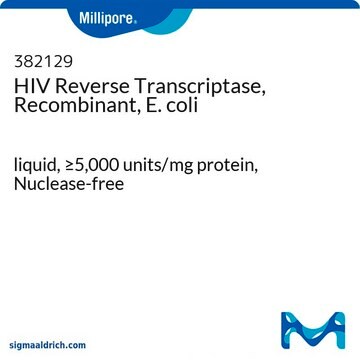ERT-RO
Roche
Expand™ Reverse Transcriptase
solution, recombinant, expressed in E. coli (AP401 (k)), sufficient for 20 reactions, sufficient for 100 reactions
Synonim(y):
reverse transcriptase, expand
About This Item
Polecane produkty
rekombinowane
expressed in E. coli (AP401 (k))
Postać
solution
zastosowanie
sufficient for 100 reactions
sufficient for 20 reactions
opakowanie
pkg of 1,000 U (11785826001 [20 μl])
pkg of 5,000 U (11785834001 [100 μl])
producent / nazwa handlowa
Roche
Parametry
42-43 °C optimum reaction temp.
metody
RT-PCR: suitable
RT-qPCR: suitable
moc wejściowa
purified RNA
metoda wykrywania
probe-based
temp. przechowywania
−20°C
Opis ogólny
Specyficzność
Reverse Transcriptase enzyme for RT-PCR reactions up to 3 kb
Zastosowanie
Cechy i korzyści
- Obtain higher amounts of full-length cDNA transcripts and longer transcripts up to 13.5kb
- No RNase H activity
- Efficiently transcribes total RNA, mRNA, viral RNA and RNA rich in secondary structures
- Ideal for two-Step RT-PCR assay
- Purification of cDNA before PCR reaction is not necessary
Opakowanie
Definicja jednostki
Volume Activity: 50 U/μl
Inne uwagi
Informacje prawne
Tylko elementy zestawu
- Expand Reverse Transcriptase 50 U/μl
- Expand Reverse Transcriptase Buffer 5x concentrated
- DTT Stock Solution 100 mM
Hasło ostrzegawcze
Warning
Zwroty wskazujące rodzaj zagrożenia
Zwroty wskazujące środki ostrożności
Klasyfikacja zagrożeń
Eye Irrit. 2
Kod klasy składowania
12 - Non Combustible Liquids
Klasa zagrożenia wodnego (WGK)
WGK 1
Temperatura zapłonu (°C)
does not flash
Certyfikaty analizy (CoA)
Poszukaj Certyfikaty analizy (CoA), wpisując numer partii/serii produktów. Numery serii i partii można znaleźć na etykiecie produktu po słowach „seria” lub „partia”.
Masz już ten produkt?
Dokumenty związane z niedawno zakupionymi produktami zostały zamieszczone w Bibliotece dokumentów.
Klienci oglądali również te produkty
Powiązane treści
RT-qPCR detects specific targets with applications in gene expression and pathogen detection.
RT-qPCR wykrywa określone cele z zastosowaniami w ekspresji genów i wykrywaniu patogenów.
Nasz zespół naukowców ma doświadczenie we wszystkich obszarach badań, w tym w naukach przyrodniczych, materiałoznawstwie, syntezie chemicznej, chromatografii, analityce i wielu innych dziedzinach.
Skontaktuj się z zespołem ds. pomocy technicznej














